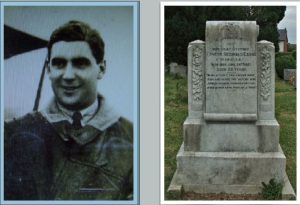Royal Air Force

Ernest Reginald Danks originated from Dudley, Worcestershire although he was born on 20 November 1895 at Claremont Street, Old Hill, Staffordshire.
He was the son of Thomas Albert and Annie Eliza Danks, however at the time of the 1901 census he was visiting his uncle, Alfred B C Danks and wife Emily and when the 1911 census was taken he was a boarder (age 15) at Wolverley School, Wolverley, Kidderminster, Worcestershire.
Between the years of 1910 and 1914 he worked in Gloucester for Alfred Danks Ltd in engineering at their Westgate Works.
This company produced steam boilers and was well known in the city, the owner was Alfred B C Danks, Ernest’s uncle. He has a Medal Index Card (MIC) at the National Archives, which shows that he was originally 5643 Air Mechanic 1st Class in the Royal Flying Corps (RFC) and was commissioned on 12 October 1916.
There is a MIC for someone of his name serving as 15432 Private in the Worcestershire Regiment, who went to France on 17 March 1915. Possibly this indicates service in the Worcesters prior to the RFC but this cannot be verified.
The Royal Flying Corps was absorbed into the Royal Air Force (RAF) on 1 April 1918 and the RAF Service Record for Ernest at the National Archives (AIR 76/121/192) indicated his next of kin to be his uncle, Alfred B C Danks, at Northfield, Hucclecote.
Ernest gained his Royal Aero Club Aviator’s Certificate (number 4686) on 23 May 1917.
He was promoted to Lieutenant in May 1918. For the remainder of the war he appears to have served in various training establishments before arriving at 62 Squadron on 21 February 1919. Later that year, on 19 August 1919, he was posted to 22 Squadron, based in Germany, as part of the Army of the Rhine.
His record notes his special qualifications as ‘general engineering’. The record also indicates that since joining the RFC he had flown a variety of aircraft, including the DH4, RE8, Fe2b, BE2c and 2d, Armstrong Whitworth, HP and Caudron.
Whilst in the ranks he was in charge of the machine shop No 1 AD (Air Depot?), British Expeditionary Force, which indicates service in France or Belgium.
His record gives little or no information with regard to any medical problems, other than the need for some dental treatment in mid-1918 and an unspecified injury due to an aero accident in the UK on 27 December 1917.
He died, cause of death unknown, at Northfield, Hucclecote on 26 June 1921, aged 25, and a private stone cross, bearing the RAF badge, was placed on his grave in the churchyard of Hucclecote Parish Church. The inscription reads that it was erected ‘in loving memory of our dear brother’.
The funeral was reported in the Gloucester Citizen of 30 June 1921 but it did not state the cause of death, only the location and gave a list of mourners. These included ‘works staff’ from Alfred Danks Ltd, so it would appear that he returned there after leaving military service.
Although his death was almost three years after the 1918 Armistice if it was related to war service or he was a reservist then he would qualify for inclusion in the CWGC Register, the cut-off date for which is 31 August 1921.
According to his Medal Index Card, his medals were returned unclaimed and his estate appears to have been administered by a Florence May Danks, spinster, who may have been a cousin.
Researched by Graham Adams 1 April 2014
